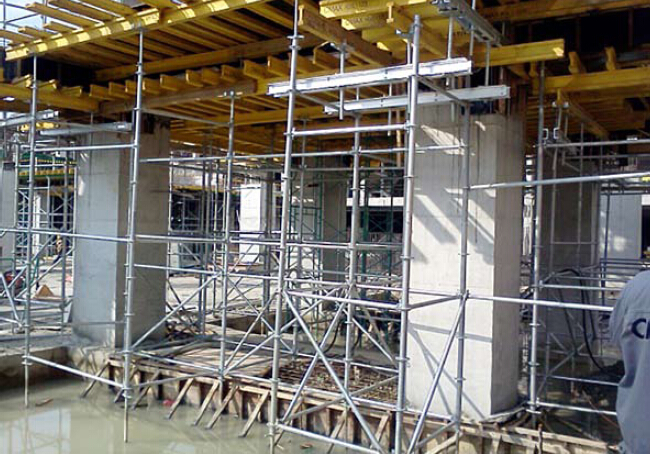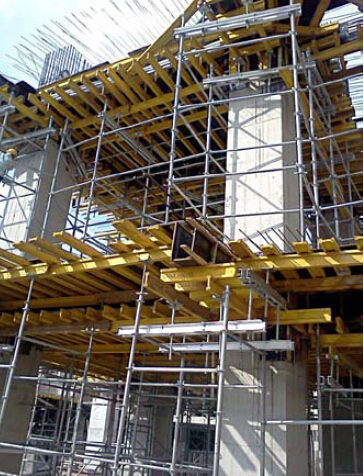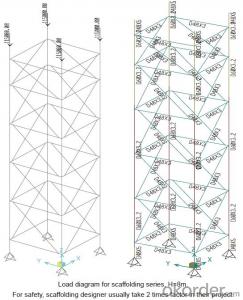Ringlock Scaffolding accessories for formwork and scaffolding system
- Loading Port:
- Tianjin
- Payment Terms:
- TT OR LC
- Min Order Qty:
- 50 m²
- Supply Capability:
- 1000 m²/month
OKorder Service Pledge
Quality Product, Order Online Tracking, Timely Delivery
OKorder Financial Service
Credit Rating, Credit Services, Credit Purchasing
You Might Also Like
Ring-lock Scaffolding
A support system for construction, ownsadvantages of both cup-lock scaffolding andshoring tower.
It is in the development direction of new typescaffolding.
It is widely used in buildings, bridges, tunnels etc..
Characteristics:
◆ Easy to storage and transportation
◆ High degree of standardization
◆ Easy and quick erection
◆ Excellent stability and bearing capacity


- Q:How does steel formwork contribute to faster construction?
- Steel formwork contributes to faster construction in several ways. Firstly, steel formwork is highly durable and can withstand multiple uses. This means that it can be reused on multiple construction projects, reducing the need to constantly manufacture new formwork. This not only saves time but also reduces costs associated with purchasing new materials for each project. Additionally, steel formwork is quick and easy to assemble and disassemble. The modular nature of steel formwork allows for efficient installation and removal, enabling construction teams to complete projects at a faster pace. This is particularly beneficial in projects with tight timelines or where speed is of the essence. Furthermore, steel formwork provides a smooth and consistent surface finish, which eliminates the need for additional plastering or finishing work. This saves time and effort during the construction process, as there is no need to wait for plaster or other finishing materials to dry before proceeding to the next stage. Moreover, steel formwork allows for greater flexibility in design. Steel can be easily fabricated into various shapes and sizes, enabling the construction of complex structures. This versatility eliminates the need for costly and time-consuming custom formwork solutions, as steel formwork can be adapted to meet the specific requirements of each project. Lastly, steel formwork is known for its excellent strength and stability. It can withstand heavy loads and adverse weather conditions, ensuring the safety and stability of the construction site. This reduces the risk of delays due to structural issues or the need for additional reinforcements, allowing the construction process to progress smoothly and efficiently. Overall, the use of steel formwork in construction projects contributes to faster construction by providing durability, easy assembly and disassembly, a smooth surface finish, design flexibility, and enhanced strength and stability. These factors combined help to streamline the construction process and reduce the overall project timeline.
- Q:What are the typical fire resistance ratings of steel formwork systems?
- Steel formwork systems can have varying fire resistance ratings due to factors like the type and thickness of the steel used, as well as the overall design and construction of the system. However, steel formwork systems are generally known for their high fire resistance properties. Steel, being a non-combustible material, does not contribute to the spread or intensity of fire. It has a high melting point and does not ignite or release flammable gases when exposed to fire. Consequently, steel formwork systems can withstand high temperatures and offer excellent fire resistance. Often, steel formwork systems are designed to meet or exceed specific fire resistance ratings set by building codes and regulations. These ratings are typically expressed in terms of time, such as 1 hour, 2 hours, or more, representing the duration for which the formwork system can maintain its structural integrity and protect against fire. To further enhance the fire resistance of steel formwork systems, additional measures like fire-resistant coatings or insulation materials can be incorporated. These measures provide an extra layer of protection, increasing the overall fire resistance of the formwork system. It's important to note that fire resistance ratings may also depend on other factors, such as the presence of fire-resistant materials in the surrounding structure and the implementation of overall fire safety measures in the building. Therefore, consulting with structural engineers, architects, and fire safety experts is crucial to determine the specific fire resistance requirements and ratings for steel formwork systems in a given construction project.
- Q:What is the maximum concrete pressure that steel formwork can withstand?
- The ability of steel formwork to withstand the maximum pressure of concrete depends on various factors, including the specific design and construction of the formwork system. However, when compared to other types of formwork materials, steel formwork generally has the capacity to withstand higher concrete pressures. Typically, the maximum concrete pressure that steel formwork can endure ranges from 50 to 100 kilonewtons per square meter (kN/m²) or 7.2 to 14.4 pounds per square inch (psi). This level of pressure is suitable for a wide range of construction projects, such as high-rise buildings, bridges, and other structures that involve substantial concrete pours. It is worth noting that the determination of the maximum concrete pressure that steel formwork can withstand should always be carried out by a qualified engineer or designer. They will take into account factors like the height and thickness of the concrete pour, the arrangement and dimensions of the formwork supports, and the strength and stability of the steel formwork system. By adhering to the recommended limits for maximum concrete pressure, construction professionals can ensure the safety and integrity of the formwork system. This will help minimize the risk of failure or collapse and ensure the successful pouring of concrete.
- Q:How is steel formwork assembled?
- Steel formwork, also known as steel shuttering, is a popular choice for construction projects due to its durability and reusability. The assembly process of steel formwork involves a series of steps to ensure a secure and stable structure. Firstly, the steel formwork panels are laid out on the construction site in the desired configuration. These panels are typically made of high-quality steel and come in various sizes and shapes to accommodate different project requirements. Next, the panels are interconnected using different types of fastening systems, such as clamps, bolts, or pins. This ensures that the formwork remains rigid and stable during concrete pouring and curing. The fastening system used may vary depending on the specific design and requirements of the project. Once the panels are securely connected, adjustable props or braces are installed to provide additional support and stability to the formwork. These props are usually made of steel and can be adjusted in height to accommodate different concrete pouring heights. After the formwork structure is assembled and properly supported, it is ready for concrete pouring. The formwork acts as a mold, containing the fresh concrete until it hardens and gains sufficient strength. The concrete is poured into the formwork using pumps or buckets, and then it is vibrated or compacted to eliminate air pockets and ensure proper adhesion. Once the concrete has cured and gained sufficient strength, the formwork is carefully dismantled. The dismantling process involves removing the props, unfastening the panels, and carefully disassembling the formwork structure. The dismantled steel formwork can then be cleaned, inspected, and reused for future construction projects, making it a cost-effective and sustainable choice. Overall, the assembly of steel formwork involves laying out and connecting the steel panels, installing adjustable props for support, pouring concrete, and finally dismantling the formwork structure. This process ensures a robust and stable formwork system that facilitates efficient and high-quality concrete construction.
- Q:How does steel formwork contribute to the overall durability of the concrete structure?
- Steel formwork contributes to the overall durability of a concrete structure by providing a strong and rigid framework that holds the concrete in place during the pouring and curing process. It ensures proper alignment and shape, preventing any deformation or cracking in the concrete. Additionally, steel formwork is highly resistant to wear and tear, allowing for multiple reuses, reducing construction costs, and increasing the lifespan of the structure.
- Q:How does steel formwork handle formwork stability during concrete pouring?
- Steel formwork provides excellent formwork stability during concrete pouring due to its high strength and rigidity. It can withstand the pressure and weight of the fresh concrete without deformation or collapse, ensuring the desired shape and structure of the concrete elements. Additionally, steel formwork can be easily adjusted and secured in place, allowing for precise alignment and stability during the pouring process.
- Q:How does steel formwork prevent concrete mixture separation during pouring?
- Steel formwork is used in construction projects to provide a temporary structure that holds the concrete in place until it sets and hardens. One of the key benefits of using steel formwork is that it prevents the concrete mixture from separating during the pouring process. The steel formwork is carefully designed and constructed to create a tight enclosure for the concrete, ensuring that it remains in its desired shape and consistency. It is made up of steel panels and frames that are securely fastened together to create a rigid structure. When the concrete mixture is poured into the steel formwork, it is held in place by the walls of the formwork itself. The steel panels and frames provide a smooth and even surface for the concrete to be poured onto, preventing any separation or segregation of the mixture. Furthermore, the steel formwork is designed with properly aligned joints and connections, which further helps in preventing any leakage or seepage of the concrete mixture. This ensures that the concrete remains intact and does not separate into its constituent materials such as aggregates, cement, and water. Additionally, the steel formwork is capable of withstanding the pressure exerted by the weight of the concrete. This prevents any deformation or movement of the formwork during the pouring process, which could potentially cause the concrete to separate or shift. Overall, the use of steel formwork provides a strong and stable structure that prevents the concrete mixture from separating during pouring. It ensures that the concrete remains in its desired form and consistency, resulting in a high-quality and durable finished product.
- Q:How does steel formwork contribute to the overall sustainability credentials of the project?
- Steel formwork contributes to the overall sustainability credentials of a project in several ways. Firstly, steel is a highly durable material that can be reused multiple times, reducing the need for constant replacement and minimizing waste generation. This not only saves costs but also reduces the environmental impact associated with the production and disposal of formwork materials. Additionally, steel formwork is known for its strength and stability, allowing for efficient and accurate construction processes. This results in reduced material waste and optimized resource utilization. The use of steel formwork also enables faster construction cycles, leading to shorter project durations and decreased energy consumption. Moreover, steel is a recyclable material, meaning that at the end of its life cycle, it can be easily recycled and transformed into new products, reducing the demand for virgin materials and the associated carbon emissions. This circular approach to materials management enhances the sustainability of the project and contributes to a more resource-efficient construction industry. Furthermore, steel formwork offers design flexibility, allowing for the creation of complex shapes and structures. This versatility promotes innovative architectural solutions that can potentially optimize energy efficiency and enhance the overall sustainability of the building design. Lastly, steel formwork can improve the safety and health standards on a construction site. Its robustness and stability ensure a secure working environment, reducing the risk of accidents and injuries. By prioritizing worker well-being, steel formwork contributes to the sustainable development of the project by fostering a responsible and ethical approach to construction practices. In summary, steel formwork contributes to the overall sustainability credentials of a project by reducing waste generation, optimizing resource utilization, enabling faster construction, promoting circular material management, enhancing design flexibility, and prioritizing worker safety.
- Q:What are the common design considerations for steel formwork in seismic areas?
- Some common design considerations for steel formwork in seismic areas include ensuring adequate strength and stiffness of the formwork system to withstand seismic forces, incorporating proper bracing and reinforcement to prevent collapse or deformation during an earthquake, using flexible connections to allow for movement and prevent stress concentration, considering the weight and stability of the formwork system to minimize the risk of overturning or sliding, and following local building codes and regulations specific to seismic design.
- Q:How does steel formwork contribute to the overall structural integrity of a building?
- Steel formwork plays a crucial role in contributing to the overall structural integrity of a building. Firstly, steel formwork provides a robust framework for pouring and shaping concrete, ensuring that it maintains the desired shape and dimensions during the construction process. This is particularly important for complex or irregular structures, where the use of steel formwork allows for accurate and precise construction. Furthermore, steel formwork offers excellent strength and durability, which enhances the structural integrity of the building. Steel is inherently strong and can withstand heavy loads, making it suitable for supporting the weight of concrete and other construction materials. This strength ensures that the formwork remains stable and secure, preventing any potential collapse or deformation during the construction process. Additionally, steel formwork provides excellent dimensional stability, which is vital for maintaining the structural integrity of the building. Steel is resistant to warping, shrinking, or expanding due to changes in temperature or humidity, ensuring that the formwork retains its shape and does not compromise the structural stability of the building. Moreover, the use of steel formwork allows for efficient and speedy construction, which can also contribute to the overall structural integrity of the building. Steel formwork systems are reusable and can be easily assembled and disassembled, enabling faster construction cycles. This reduces the risk of errors or delays, ensuring that the building is constructed in a timely manner and minimizing potential structural issues that may arise from prolonged construction periods. In conclusion, steel formwork is essential for ensuring the overall structural integrity of a building. Its robustness, strength, dimensional stability, and efficiency contribute to the accurate construction and support of the building's structural components, ultimately ensuring its safety and durability.
1. Manufacturer Overview |
|
|---|---|
| Location | |
| Year Established | |
| Annual Output Value | |
| Main Markets | |
| Company Certifications | |
2. Manufacturer Certificates |
|
|---|---|
| a) Certification Name | |
| Range | |
| Reference | |
| Validity Period | |
3. Manufacturer Capability |
|
|---|---|
| a)Trade Capacity | |
| Nearest Port | |
| Export Percentage | |
| No.of Employees in Trade Department | |
| Language Spoken: | |
| b)Factory Information | |
| Factory Size: | |
| No. of Production Lines | |
| Contract Manufacturing | |
| Product Price Range | |
Send your message to us
Ringlock Scaffolding accessories for formwork and scaffolding system
- Loading Port:
- Tianjin
- Payment Terms:
- TT OR LC
- Min Order Qty:
- 50 m²
- Supply Capability:
- 1000 m²/month
OKorder Service Pledge
Quality Product, Order Online Tracking, Timely Delivery
OKorder Financial Service
Credit Rating, Credit Services, Credit Purchasing
Similar products
New products
Hot products
Hot Searches
Related keywords
























